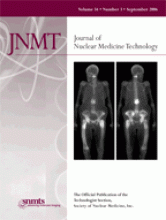
BETH HARKNESS, CNMT
Fall has always been my favorite time of year. I think this harkens back to my childhood and the excitement of returning to school, meeting up with friends I hadn't seen over the summer, and that wonderful feeling that this year all things are possible. And there were associated perks to look forward to, like new school supplies, books, and clothes, though not necessarily in that order.
It's been a long time since I set off for school with all my pencils still seven inches long, yet I still have that sense of a new beginning each September. Like many others, fall imbues me with a desire to plant bulbs, paint the porch, and get cracking on that to-do list I've been adding to all year. I also think of this as a time to reflect on the things I want to accomplish in the coming academic year.
This year for me these thoughts are distinctly different than in the previous six years. This year I am not thinking about what I want to do with the Journal of Nuclear Medicine Technology, since I will be stepping down as editor-in-chief in December. This year my thoughts are turning toward what I want to accomplish professionally. My own papers have languished as I have been occupied reviewing and publishing those written by others. I still have articles in progress that I was working on when I started my tenure as editor—most will have to be relegated to a pile metaphorically stamped “already published by others” or “no longer relevant.” So this year, one of my priorities is to prepare some of my own work for publication.
At the 2006 SNM Annual Meeting there were many excellent papers and posters presented by technologists. Each of those individuals have already done most of the work necessary to produce a scientific paper. They have done the research and written a presentation. The next logical step in the process is to put their presentation into scientific paper format and submit it for publication. (See the March issue of JNMT [2006;34:53–9] for an excellent guide that will help any author with this process.) If they don't take this final step, one day they, too, will be looking at a pile of their own wonderful, original research “already published by others.”
Many technologists submit abstracts for the annual meeting because having an abstract accepted for presentation helps justify their attendance (and funding), and that's the way it is supposed to work. But the research that is shared at the annual meeting, important as it is, is far more limited than research that is published in a peer-reviewed journal. Published research has legs. It has shelf life. Published research becomes available at the click of a mouse to the entire world … essentially forever. If you think it feels good to have someone tell you how much they enjoyed your presentation at a meeting, wait until someone from the other side of the world tells you how helpful they found your journal article!
Maybe you didn't present a scientific paper at the annual meeting this year. You can still contribute to JNMT. The editor is always looking for cover art. The technologist that submits the cover image is recognized in the table of contents. Or you could submit a case report that has a strong technical component. There are many ways to get into the publishing cycle.
So, if you are like me, and fall fires up the engine of your ambition, think about ways you can renew your professional life by publishing your work. There is a real sense of accomplishment just waiting for you. This year, anything is possible.







